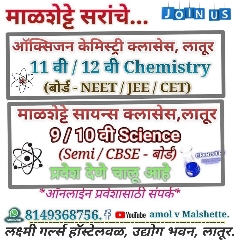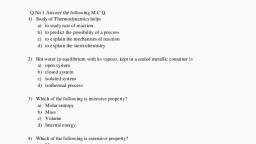Question 3 :
In thermodynamics, which one of the following properties is not an intensive property?
Question 7 :
$C_v$ for helium gas $(He)$ is $(in J \ mol^{-1} \ K^{-1})$
Question 8 :
${ N }_{ 2 }(g)+3{ H }_{ 2 }(g)\rightleftharpoons 2N{ H }_{ 3 }(g)$<br>$\Delta { H }^{ o }=-18\quad kJ$<br>According to Le-Chateliers principal the favourable condition for good yield of $NH_{3}$
Question 9 :
At the boiling point of water the saturated vapour pressure will be (in mm of Hg)
Question 10 :
Warming ammonium chloride with sodium hydroxide in a test tube is an example of:
Question 12 :
For a reaction to be spontaneous in neither direction, which of the following is/are correct regarding the closed system?<br>(1) ${ \left( \Delta { G } \right) }_{ T,P }=0$<br>(2)${ \left( \Delta { G } \right) }_{ T,P }< 0$<br>(3) ${ \left( \Delta { G } \right) }_{ U,V }=0$<br>(4) ${ \left( \Delta { G } \right) }_{ U,V }>0$<br>Codes:
Question 13 :
Which one of the following systems is an example of a closed system?
Question 15 :
Magnitude of Seebeck emf between the junctions does not depend on
Question 17 :
The temperature at the bottom of a high water fall is higher than that at the top because
Question 18 :
Properties of substances like pressure, temperature and density, in thermodynamic coordinates are
Question 20 :
When 1 mol gas is heated at constant volume temp. is raised from 298 to 308 K. Heat supplied to the gas is 500 J. Then which statement is <span>correct?</span>
Question 21 :
Amongst the following, the total number of physical properties which are extensive are:<br><b>a. </b>density<br><b>b.</b> viscosity<br><b>c. </b>surface tension<br><b>d.</b> dipole moment<br><b>e.</b> volume<br><b>f.</b> refractive index<br><b>g.</b> $\Delta G$<br><b>h.</b> $\Delta H$<br><b>i.</b> $\Delta U$<br><b>j.</b> $\Delta S$<br>
Question 22 :
In a closed system : $A\left( s \right) \rightleftharpoons 2B\left( g \right) +3C\left( g \right) $ if the partial pressure C is of doubled then partial pressure B wil be:
Question 23 :
Which of the following parameters does not charaterize the thermodynamic state of matter?
Question 24 :
A system which can neither exchange matter nor energy with surrounding is called isolated system .If true enter 1 else 0<br>
Question 26 :
System in which there is no exchange of matter, work or energy from surroundings is
Question 28 :
Equal masses of hydrogen gas and oxygen gas are placed in a closed container at a pressure of $3.4 atm$. The contribution of hydrogen gas to the total pressure is:
Question 29 :
The symbols $F.H.S.{V}_{m}$ and ${E}^{o}$ denote Helmholtz free energy, enthalpy, entropy, molar volume and standard electrode potential, respectively. The correct classification of the properties is:
Question 32 :
The value closest to the thermal velocity of a Helium atom at room temperature (300 K) in $ms^{-1}$ is : [$k_B = 1.4 \times 10^{-23} \ J/K ; \ m_{He} = 7\times 10^{-27} \ kg$ ]
Question 33 :
Which of the following is an extensive property?<br/><span>a. Volume </span><br/><span>b. Surface tension.</span><br/><span>c. Viscosity </span><br/><span>d. Density</span><br/>
Question 34 :
If the pressure of $N_2/H_2$ mixture in a closed apparatus is $100$ atm and $20\%$ of the mixture reacts then the pressure at the same temperature would be:
Question 35 :
If in a container neither mass and nor heat exchange occurs then it constitutes a:
Question 36 :
When a volatile liquid is introduced into an evacuated closed vessel at a particular temperature, both evaporation and condensation take place simultaneously. The system reaches equilibrium state when:
Question 37 :
A system which cannot exchange matter and energy with the surroundings called isolated.<br/>
Question 38 :
If a closed system has adiabatic boundaries, then atleast one boundary must be:
Question 39 :
What will be the stable state of aggression of carbon at $298 K$ and 1 atm pressure?<br/>
Question 40 :
Assertion: The graph between $P\ V/s \dfrac {1}{V}$ is a straight line.
Reason: For adiabatic process $P\propto \dfrac {1}{V}$
Question 41 :
A child bought a balloon which became very small in size the next day. Which is correct statement about balloon?
Question 43 :
<span class="wysiwyg-font-size-small"><span class="wysiwyg-font-size-small"></span></span><p class="wysiwyg-text-align-left">Assertion (A): A system is said to be closed if it can exchange energy but not matter. </p><p class="wysiwyg-text-align-left">Reason (R): Coffee in a stoppered thermos flask is an example of closed system.<br/></p>
Question 45 :
Water of mass $m_2$ = 1 kg is contained in a copper calorimeter of mass $m_1$ = 1 kg. Their common temperature t = $10^{0}C$. Now a piece of ice of mass $m_3$ = 2 kg and temperature is $-11^{0}C$ dropped into the calorimeter. Neglecting any heat loss, the final temperature of system is. [specific heat of copper = 0.1 Kcal/ kg$^{0}C$, specific heat of water = 1 Kcal/kg$^{0}C$, specific heat of ice = 0.5 Kcal/kg$^{0}C$, latent heat of fusion of ice = 78.7 Kcal/kg]
Question 46 :
Two closed vessel $A$ and $B$ of equal volume of $8.21L$ are connected by a narrow tube of negligible volume with open valve. The left hand side container id found to contain $3\ mole \, CO_2$ and $2\ mole$ of $He$ at $400K$. What is the partial pressure of $He$ in vessel $B$ at $500K$?
Question 49 :
Assertion: $ \Delta H $ for exothermic reaction is negative and for endothermic reaction is positive.
Reason: Enthalpy is an extensive property.
































